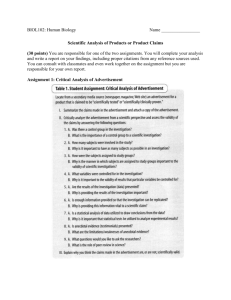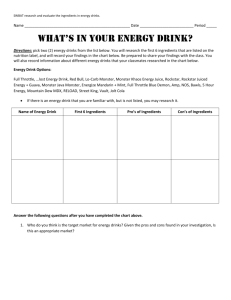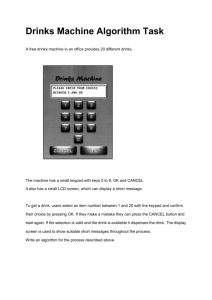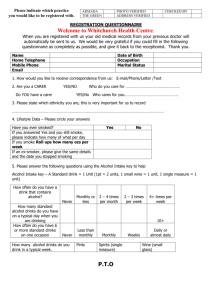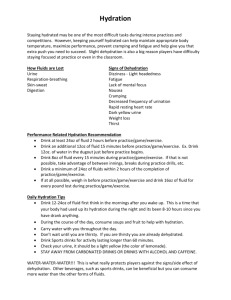A Can of Bull? - Villanova University
advertisement
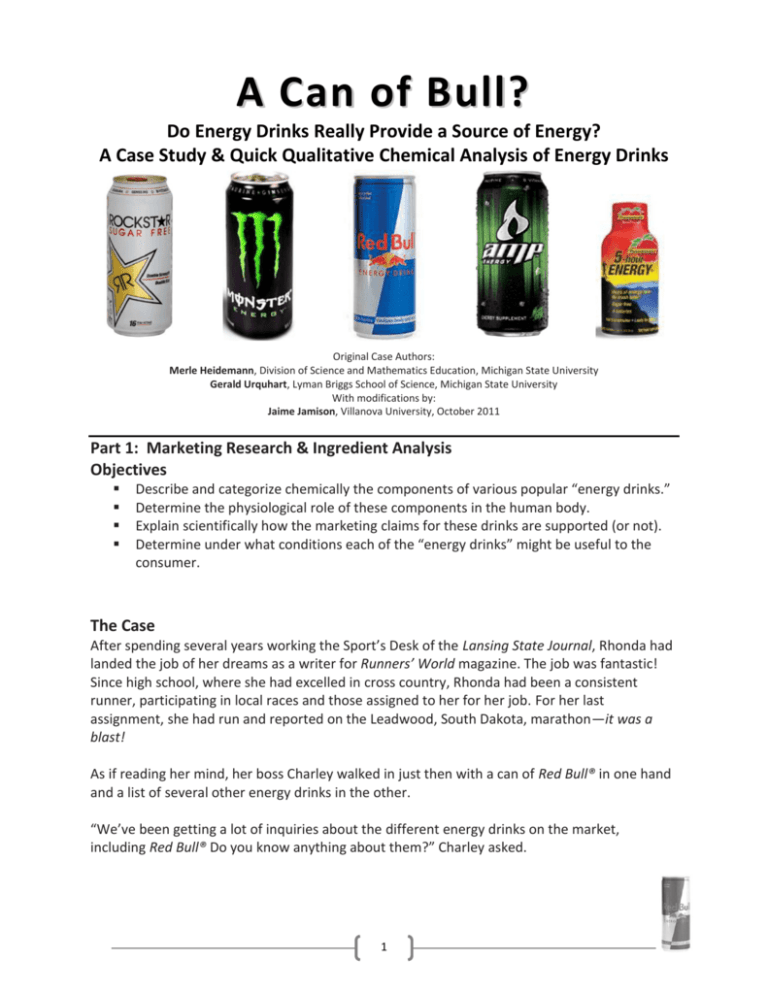
A Can of Bull?
Do Energy Drinks Really Provide a Source of Energy?
A Case Study & Quick Qualitative Chemical Analysis of Energy Drinks
Original Case Authors:
Merle Heidemann, Division of Science and Mathematics Education, Michigan State University
Gerald Urquhart, Lyman Briggs School of Science, Michigan State University
With modifications by:
Jaime Jamison, Villanova University, October 2011
Part 1: Marketing Research & Ingredient Analysis
Objectives
Describe and categorize chemically the components of various popular “energy drinks.”
Determine the physiological role of these components in the human body.
Explain scientifically how the marketing claims for these drinks are supported (or not).
Determine under what conditions each of the “energy drinks” might be useful to the
consumer.
The Case
After spending several years working the Sport’s Desk of the Lansing State Journal, Rhonda had
landed the job of her dreams as a writer for Runners’ World magazine. The job was fantastic!
Since high school, where she had excelled in cross country, Rhonda had been a consistent
runner, participating in local races and those assigned to her for her job. For her last
assignment, she had run and reported on the Leadwood, South Dakota, marathon—it was a
blast!
As if reading her mind, her boss Charley walked in just then with a can of Red Bull® in one hand
and a list of several other energy drinks in the other.
“We’ve been getting a lot of inquiries about the different energy drinks on the market,
including Red Bull® Do you know anything about them?” Charley asked.
1
“I know that people use them for various reasons,” replied Rhonda. “It seems they’re primarily
used by athletes to provide some ‘fuel’ as they practice and compete. Other people use them
more casually as a way to become ‘energized.’ That’s about all I know.”
“That seems to be about all any of us knows,” Charley said.
“For your next assignment,” Charley continued, “I want you to find out what each of the
ingredients in these drinks is and what it does for a runner or for a non-athlete. You need to be
very accurate in your analysis—determine what each component really does for the body, not
what the marketers want you to believe it does. Then look at the marketing claims of some of
these drinks and see if the scientific facts match up to them. Many of our readers
are using these drinks with some general notion that they’re helpful, but they’re basing their
use of them on no scientific information. I’ve got the marketing claims, a list of ingredients and
nutrition facts provided on the cans for consumers, and a short list of questions that should get
you started. When you research these, be sure to document all your sources of information,
keeping in mind that all resources are not equal. Here’s the information.”
With that, Charley left the office. Rhonda looked over the list. “Guess I’ll have to brush up on
my biochemistry. No problem. I’m interested in knowing if my running would be improved by
drinking this stuff.”
Rhonda recalled that a food’s calorie content was the simplest reflection of its energy content.
Looking at Charley’s list she saw that the different energy drinks contained the following
numbers of calories:
Energy Drink
ROCKSTAR Sugar Free®
Monster Energy®
Red Bull®
AMP®
5-hour ENERGY®
Calories Per Serving:
10
100
110
110
4
For comparison:
Coca Cola® (12 oz)
140
2
Marketing Claims
Next, Rhonda perused the marketing claims for each drink:
ROCKSTAR Sugar Free®
Bigger. Better. Faster. Stronger. The world’s most powerful energy drink is now
available Sugar Free!
Double strength. Double size.
Formulated with caffeine, guarana, ginseng, B-vitamins, and taurine.
Enhanced with the potent herb Milk Thistle, ROCKSTAR is scientifically formulated to
provide an incredible energy boost for those who lead active and exhausting lifestylesfrom athletes to rockstars.
Monster Energy®
“Unleash the Beast! ®”
Tear into a can of the meanest energy supplement on the planet, Monster energy.
Monster is a wicked mega hit that delivers twice the buzz of a regular energy drink.
Formulated with L-carnitine, taurine, ginseng, and B-vitamins.
Monster packs a vicious punch but has a smooth flavor you can really pound down.
Red Bull®
The Red Bull energy drink is a functional product developed especially for periods of
increased mental and physical exertion.
Made with taurine. Vitalizes body and mind.
It can be drunk in virtually any situation: at sport, work, study, driving and socializing.
Improves performance, especially during times of increased stress or strain.
Increases endurance. Improves concentration and reaction speed.
Stimulates the metabolism.
3
Marketing Claims - continued
AMP Energy®
The Power of AMP Energy gets you focused and ready for everything life throws at you
each day. Or night.
With its energizing blend of B-vitamins and a specially formulated intense combination
of taurine, ginseng, guarana, AMP Energy keeps you connected and on top of your game
at all times.
AMP Energy – more power to you.
5-hour ENERGY®
Don’t drink energy drinks. Take 5-hour ENERGY®.
When you need an extra boost and don’t want to wait. You want to feel more energetic
now. A 5-hour ENERGY® shot takes just seconds to take, so it gets in your system fast.
A 5-hour ENERGY® shot can help you feel awake and alert for hours. It wears off
gradually so you do not feel a “crash”.
Quick, simple & effective. Fast & easy to drink.
Zero sugar, zero herbal stimulants, zero carbonation, and 4 calories.
Packed with B-vitamins and amino acids and only contains as much caffeine as a cup of
the leading premium coffee.
Charley’s List of Questions
Rhonda realized that before she could start analyzing the energy drinks, she needed to know
the answer to the following question:
When we say that something gives us “energy,” what does that mean? What is a
biological definition of energy?
After satisfying herself that she had a good definition, she turned to the first set of questions on
Charley’s list.
1. What is the nature (sugar, amino acid, vitamin, stimulant, etc.) of each ingredient
listed on the cans?
2. What is the physiological role of each in the human body?
3. Which ingredients provide energy?
4. Which ingredients contribute to body repair, i.e., which help build or rebuild muscle
tissue?
4
Rhonda was determined to wade through the confusing labeling of the drinks. For example, 5hour ENERGY ® boasted that it had only 4 calories but still provided “energy.” That made
absolutely no sense based on what Rhonda knew about biological energy! The first thing she
needed to do was sort out the various ingredients on the labels—a task that consumers rarely
undertake.
Ingredients & Nutrition Facts
As in most labels, listed in order of mass in drinks (highest to lowest).
ROCKSTAR Sugar Free®
Ingredients: carbonated water, citric acid, taurine, natural and artificial flavors, sodium
citrate, caffeine, caramel color, benzoic acid, sorbic acid, acesulfame potassium,
sucralose, l-carnitine, inositol, niacinamide, calcium pantothenate, milk thistle extract,
ginkgo biloba leaf extract, guarana seed extract, panax ginseng root extract, riboflavin,
pyridoxine hydrochloride, cyanobalamin.
Nutrition Facts: serving size: 8 fl oz; servings per container: 2; calories: 10; fat: 0g;
sodium: 125mg; potassium: 0mg; total carbs: 0g; sugars: 0g; protein: 0g; vitamin B2:
200%; vitamin B3: 100%; vitamin B5: 100%; vitamin B6: 100%; vitamin B12: 100%;
taurine: 1000mg; ginkgo biloba leaf extract: 150mg; caffeine: 80mg; guarana seed
extract: 25mg; inositol: 25mg; L-carnitine: 25mg; panax ginseng extract: 25mg; milk
thistle extract: 20mg.
Monster Energy®
Ingredients: carbonated water, sucrose, glucose, citric acid, natural flavors, taurine,
sodium citrate, color added, panax ginseng root extract, l-carnitine, caffeine, sorbic acid,
benzoic acid, niacinamide, sodium chloride, glucuronolactone, inositol, guarana seed
extract, pyridoxine hydrochloride, sucralose, riboflavin, maltodextrin, cyanobalamin.
Nutrition Facts: serving size: 8 fl oz; servings per container: 2; amount per serving:
calories: 100; total fat: 0g; protein: 0g; total carbohydrates: 27g; sugars: 27g; riboflavin:
1.7mg, niacin: 20mg; vitamin B6: 100%; vitamin B12: 100%; sodium: 180mg; taurine:
1000mg, panax ginseng: 200mg; energy blend (l-carnitine, glucose, caffeine, guarana,
inositol, glucoronolactone, maltodextrin): 2500mg.
5
Ingredients & Nutrition Facts - continued
Red Bull®
Ingredients: carbonated water, sucrose, glucose, citric acid, taurine, sodium citrate,
magnesium carbonate, caffeine, glucuronolactone, inositol, niacinamide, calcium
pantothenate, pyridoxine HCl, vitamin B12, natural and artificial flavors, colors.
Nutrition Facts: serving size: 8.4 fl oz; servings per container: 1; amount per serving:
calories: 110; total fat: 0g; sodium: 100mg; total carbohydrates: 28g; sugars: 27g
protein: less than 1g; niacin: 100%; vitamin B6: 250%; vitamin B12: 80%; pantothenic
acid: 50%.
AMP Energy®
Ingredients: carbonated water, high fructose corn syrup, citric acid, orange juice
concentrate, natural flavor, guarana seed extract, sodium benzoate, sodium
hexametaphosphate, maltodextrin, caffeine, gum Arabic, ascorbic acid, taurine, panax
ginseng root extract, calcium disodium EDTA, brominated vegetable oil, niacinamide,
yellow 5, calcium pantothenate, riboflavin, pyridoxine hydrochloride (vitamin B6), Blue
1, cyanocobalamin (vitamin B12).
Nutrition Facts: serving size: 8 fl oz; servings per container: 2; calories: 110; fat: 0g; total
carbs: 29g; sugars: 29g; protein: 0g; riboflavin: 0.34mg; niacin: 10%; vitamin B6: 10%;
vitamin B12: 10%; pantothenic acid: phosphorus: 4%; sodium: 65mg; guarana extract:
150mg; caffeine: 71mg; maltodextrin: 55mg; taurine: 10mg; panax ginseng extract:
10mg.
5-hour ENERGY®
Ingredients: purified water, natural and artificial flavors, sucralose, potassium sorbate,
sodium benzoate, EDTA, “energy blend”: taurine, glucouronic acid, malic acid, n-acetyl
l-tyrosine, l-phenylalanine, caffeine, citicoline.
Nutrition Facts: serving size: 1.93 fl oz; sevings per container: 1; calories: 4; fat: 0g;
total carbs: 0g; sugars: 0g; protein: 0g; niacin: 150%; vitamin B6: 2000%; folic acid:
100%; vitamin B12: 8333%; sodium: 18mg.
Coca Cola® (for later comparison)
Ingredients: carbonated water, high fructose corn syrup and/or sucrose, phosphoric
acid, natural flavors, caffeine
Nutrition Facts: serving size: 12 fl oz; servings per container: 1; calories: 140; fat: 0g;
total carbs: 38g; sugars: 38 g; protein: 0 g
6
Your Task
Working as a group, research each ingredient found in these energy drinks. This information
can be found in biochemistry and nutrition textbooks. Web sources may provide valuable
information, but be critical in their use. Many will make unsubstantiated claims. One that can
get you started for basic information is: http://www.chemindustry.com.
Basic information can also be garnered from:
http://www.usda.gov/wps/portal/usdahome - click on the “Food and Nutrition” link.
Determine the chemical structure, the type of chemical each is, and the physiological
role played by each compound listed on your energy drink label.
Example: Glucose
Chemical Structure: C6H12O6
Type of chemical: simple sugar
Physiological role: enters primary metabolic pathway in which the chemical
energy of its bonds is converted to ATP, the primary “energy” molecule in the body.
You should have sufficient information to answer Charley’s list of questions (page 4)
as well as the additional questions listed below (page 8).
Fill out the table (page 7) and answer all the questions. You should work together as
a group to answer these.
****Please cite any websites that you used in your analysis****.
Post Research Analysis
Using the information that your group gathered, place each of the ingredients for your drink
under the proper heading in the table below.
Sources of Energy
Amino Acids
Stimulants & Vitamins
7
Other – please categorize
Questions
1. When we say that something gives us “energy,” what does that mean? What is a
biological definition of energy?
2. What is the physiological role of each of the molecules in your table?
a. Which ingredients provide energy? How do they do that?
b. Which ingredients contribute to body repair, i.e., which help build or rebuild
muscle tissue?
3. In what ways might the one(s) that does (do) not have a metabolic energy source
(caffeine) provide the perception of increased energy after consumption?
4. How are the ingredients in these drinks helpful to someone expending a lot of energy,
e.g., a runner?
5. Does your analysis substantiate the claim that this is an “energy drink”? If so, what
molecules are the sources of energy?
6. Could your drink serve different purposes for different consumers? Explain.
7. What is the normal physiological response to increased intake of sugars? to increased
intake of caffeine?
8. Is there such a thing as a “sugar high”? Explain your answer.
9. Evaluate, in terms of basic physiology and biochemistry, the statement: A lack of sleep
causes a lack of energy.
10. Are the product claims legitimate? Why?
11. Should you simply buy a can of Coke® rather than one of these energy drinks?
Why/why not?
Assessment
Option A:
Individually, or as a group, write an evaluation of the marketing claims for your
drink. You may write the evaluation in the form of an article for readers of
Runner’s World. Be sure to include answers to the questions above.
Option B:
Each group will present an overall evaluation (with substantiating evidence) of
their drink to the class.
Grades for Options A & B will be based on individual and group participation, thoroughness of
research, ability to answer questions, final conclusions & class presentation.
Copyright © 2005 by the National Center for Case Study Teaching in Science.
Originally published 06/20/05 at http://www.sciencecases.org/energy_drinks/energy_drinks.asp
Please see our usage guidelines, which outline our policy
concerning permissible reproduction of this work.
8
Name: ______________________________
Date: __________________
Lab Section: __________________________
Quick Qualitative Chemical Analysis of Energy Drinks
…plus a few other beverages
Part 2: Chemical Tests for Energy Drink Components
Objectives
Perform a series of tests to detect the presence of the following organic molecules &
chemicals in energy drinks: amino acids, proteins, carbohydrates, lipids and sodium
chloride.
Use data from these chemical assays to verify the ingredients in several commercial
energy drinks for comparison with other beverages such as: Gatorade®, Mt. Dew®,
VitaminWater®, chocolate milk, etc.
You have already done the research regarding the ingredients listed on your energy drink label.
But, do these drinks really contain sugar, fat, proteins, amino acids, & sodium in detectable
amounts? Let’s find out with these simple tests. Each group will conduct a series of chemical
tests on their energy drink, plus a few other beverages. At the end of lab, each group will share
their overall conclusions with the class.
Guidelines & Precautions for All Chemical Tests
Energy drinks are non-edible lab samples. Please do not consume your lab experiment!
You must wear gloves & goggles when handling any chemical indicator. Follow all
safety directions as indicated in the procedures below.
Each test will contain two main components: sample solutions (your energy drink &
four other beverage samples), as well as controls (positive & negative).
Controls are used to validate procedures and to help you to determine
your experiment results.
Positive control: contains the target molecule (e.g. carbohydrate) for the
particular assay being performed (e.g. Benedict’s test).
Negative control: does not contain the target molecule; therefore,
should not react during the particular assay being performed.
9
#1 Testing for Proteins – The Biuret Test for Proteins
Amino acids are the small structural subunits which make up proteins. These subunits are
linked together forming long chains via strong peptide bonds. Polypeptide chains are
detectable using the Biuret Test.
How the Biuret Test works: The Biuret Reagent is a 1% solution of CuSO4 (copper sulfate). This
blue chemical forms a complex with the peptide bonds present in proteins and produces a
violet color. The Cu2+ must bind to four or more peptide bonds in order to produce this violet
color. If less than four peptide bonds are present, the reaction will not take place. Therefore,
the Biuret Test can only identify proteins, not free amino acids. You will conduct another test
for amino acids (ninhydrin test) next.
Protocol: The Biuret Test
1. Obtain 7 test tubes - you’ll need one tube per sample (energy drink + 5 others), plus one
for your positive and one for your negative control .
2. Pipette 2-ml of each solution (all drink samples & +/- controls) into the respective test
tube. Be sure to label each test tube with the contents and your initials.
3. [Wear Gloves & Goggles] Add 2-ml of Biuret Reagent to each of the tubes.
4. Mix the contents of the tubes by gently swirling.
5. Wait 2 minutes, then record your results in Table 1 below. (Remember: a positive
indication of protein is a violet, not blue color).
Table 1: Biuret Test Results
Identity of Sample
Solution
Initial Observations
(color, opaque /
translucent)
Observations
(after adding
Biuret Reagent)
Positive control
Negative control
10
Final Observations
(after 2 minutes)
Conclusion
(protein yes or no)
#2 Testing for Amino Acids – The Ninhydrin Test for Amino Acids
Amino acids are molecules comprised of carbon, hydrogen, oxygen and nitrogen. All amino
acids contain two functional groups: an amino group (-NH2) and a carboxyl group (-COOH).
Each also has a side chain, or “R” group, that various among each amino acid.
How the Ninhydrin Test works: Ninhydrin is a chemical used to detect ammonia or the amine
groups of amino acids. In the presence of free amino acids (not proteins or polypeptide chains),
the reagent turns violet/purple except in the presence of one amino acid, proline. In the case
of proline, the ninhydrin turns yellow. This is due to the fact that proline’s amino group is part
of a ring structure.
Protocol: The Ninhydrin Test
Ninhydrin is poisonous. Wear gloves & goggles and work in the fume hood only with this
chemical. Avoid contact with skin.
1. [Wear gloves] Obtain a piece of filter paper.
2. Using a pencil (not pen/marker), label sections of the paper for each sample, plus a
proline positive & negative control area. Allow enough space between test spots for
samples to spread out. See example here:
Filter paper
Sample 1
Sample 3
+ control
Sample 2
proline
Sample 3
- control
- control
Sample 4
+ control
Sample 5
3. Position the filter paper directly on the benchtop (non-absorbent surface). Using a clean
cotton swab applicator for each solution, apply a small test spot of each sample to the
corresponding area on the filter paper. Try not to allow the liquid to spread too much –
just dab the sample lightly onto the filter paper.
4. Let the samples dry completely.
5. [Gloves & Goggles, inside Fume Hood] Working in the fume hood, apply 1 drop of Ninhydrin
to each of the sample spots. You may have to guess the location somewhat as the drops
should have disappeared upon drying.
6. Allow the filter paper to dry at room temperature inside the fume hood for 20-30
minutes. Alternatively, your TA may carefully heat over a hot plate in the fume hood.
11
The reaction will occur faster if the paper is passed over heat. Care should be taken not
to burn the paper, however.
6. Observe the test spots and record the results in Table 2 below. (Remember: a positive
indication of amino acid presence is a purple color; yellow if proline).
Table 2: Ninhydrin Test Results
Identity of Sample
Solution
Initial Observations
(color of sample
spot on filter paper)
Observations
(after adding
Ninhydrin)
Final Observations
(after drying 20-30
min. or heating)
Conclusion
(amino acid yes or no)
Proline
Positive control
Negative control
#3 Testing for Carbohydrates - The Benedict’s Test for Simple Sugars
Sugars are polar and soluble in water. Carbohydrates are sometimes referred to as “CHO’s”
for the Carbon, Hydrogen, and Oxygen they are made of (1:2:1 ratio). Simple sugars,
monosaccharides, are the basic subunits of carbohydrates. When two monosaccharides pair a
disaccharide is formed. An example of a disaccharide is sucrose: fructose + glucose.
Polysaccharides are formed when three or more monosaccharides are linked together.
Examples of polysaccharides include starch, glycogen, and cellulose.
How the Benedict’s Test works: monosaccharides have functional groups called aldehydes
(-CHO) or ketones (-C=O). Both of these groups can reduce weak oxidizing agents, such as the
copper within the Benedict’s Reagent. When the copper is reduced (cupric ions to cuprous
oxide), the formation of a colored precipitate results. The cuprous oxide is green to reddishorange in color. The green indicates a small amount of reducing sugars while the reddishorange indicates a larger amount.
Protocol: The Benedict’s Test
1. Obtain 7 test tubes – you’ll need one tube per sample (energy drink + 5 others), plus
one for your positive and one for your negative control .
12
2. Pipette 2-ml of each solution (all drink samples & +/- controls) into the respective test
tube. Be sure to label each test tube with the contents and your initials. Record your
initial observations in Table 3 below.
3. [Gloves & Goggles] Add 2-ml of Benedict’s Reagent to each of the tubes.
4. Mix the contents of the tubes by gently swirling. Record the color of each solution with
Benedict’s added in Table 3 below.
5. Carefully, place the tubes into a 100oC (boiling) water bath for 3 minutes.
6. After 3 minutes, carefully remove the tubes and let them cool to room temperature.
7. Record the final color of each sample in Table 3. Indicate whether the sample contains
reducing sugars & give the relative amount (low or high). (Remember: a positive
indication of sugar is a green {low} or reddish-orange color {high}).
Table 3: Benedict’s Test Results
Identity of Sample
Solution
Initial Observations
(color, opaque /
translucent)
Observations
(after adding
Benedict’s)
Final Observations
(after 100oC)
Conclusion
(low sugar, high
sugar, no sugar)
Positive control
Negative control
#4 Testing for Lipids - The Sudan IV Test for Fats
Lipids are a group of organic molecules that are soluble in non-polar solvents (e.g. acetone), but
are insoluble in water. Lipids include fats, steroids, and phospholipids. At room temperature
solid lipids are referred to as fats, while those that are liquid are called oils.
How the Sudan IV Test works: the lipid test is based on the fact that non-polar substances,
such as Sudan IV, are selectively absorbed by lipids. If lipid is present, the red-colored Sudan IV
dye will stain the sample red. Look closely at the surface of the sample for tiny droplets of red.
Protocol: The Sudan IV Test
1. Obtain 7 test tubes – you’ll need one tube per sample (energy drink + 5 others), plus
one for your positive and one for your negative control .
13
2. Pipette 2-ml of each solution (all drink samples & +/- controls) into the respective test
tube. Be sure to label each test tube with the contents and your initials.
3. Add 2-ml of water into each tube.
4. [Gloves & Goggles] Add 5-7 drops Sudan IV stain to each of the tubes.
5. Cover the tubes securely with Parafilm. Then, mix the contents of each tube by
inverting several times (as you would mix oil & vinegar salad dressing!).
6. Record your observations in Table 4 below. (Remember: if fats or oils are present,
they will appear as floating red droplets or as a floating red layer on the surface).
Table 4: Sudan IV Test Results
Identity of Sample
Solution
Initial Observations
(color, opaque /
translucent)
Observations
(after adding
water)
Final Observations
(after adding
Sudan IV & mixing)
Conclusion
(lipids or no lipids)
Positive control
Negative control
#5 Testing for Lipids, Confirmation of Sudan IV Test - The Grease Spot Test for
Lipids (a.k.a. “fast food test”)
This test is typically used to verify the results of the Sudan IV Test. It is a simpler test for lipids,
but you must conduct the test carefully in order to obtain reliable results.
How the Grease Spot Test works: This test is based on the ability of lipids to produce a
translucent spot on brown paper bags. Think of a bag of take-out fast food that includes french
fries and a greasy hamburger. After sitting for a short time, the grease is absorbed by the paper
bag, turning it translucent.
Protocol: The Grease Spot Test
1. Obtain a piece of brown paper bag that has been cut into a rectangle.
14
2. Using a pencil (not pen/marker), label sections of the paper for each sample, plus a
positive & negative control area. Allow enough space between test spots for samples to
spread a little. See example here:
Brown paper
Sample 1
Sample 4
Sample 2
Sample 3
+ control
Sample 5
- control
3. Using a cotton swab applicator, apply a small test spot of each sample to the
corresponding area on the brown paper.
4. Let the fluids evaporate. There is a difference between the paper being “wet” and
being “translucent”.
5. Once the spots are dry, hold the paper up to a light and observe.
6. Record your observations in Table 5 below. (Remember: a positive indication of lipid is
a translucent, not wet spot, on the test area).
Table 5: Grease Spot Test Results
Identity of Sample
Solution
Observations (after
evaporation)
Translucent?
Conclusion
(lipids or no lipids)
Does this conclusion
support Sudan IV Test
results? (yes/no)
Positive control
Negative control
#6 Testing for Sodium – The Silver Nitrate Test for NaCl
Sodium is a metallic element that appears on the period table as the symbol “Na”. It is highly
reactive, but is soluble in water. Typically we think of “salt” as being NaCl, sodium plus chloride
ions, but there are other types of “salts” including potassium chloride (KCl) and calcium chloride
(CaCl2). We will test for the presence chloride ions as a proxy for sodium in the samples today.
15
How the Silver Nitrate Test works: Silver Nitrate (AgNO3) actually detects chloride ions. It
binds to a compound such as NaCl, forming a complex between the silver and the chloride.
Silver nitrate, a clear-colorless solution, turns opaque white in the presence of chloride ions (i.e.
when silver chloride, is produced).
Protocol: The Silver Nitrate Test
1. Obtain 7 test tubes – you’ll need one tube per sample (energy drink + 5 others), plus
one for your positive and one for your negative control.
2. Pipette 2-ml of each solution (all drink samples & +/- controls) into the respective test
tube. Be sure to label each test tube with the contents and your initials. Record the
initial color of each in Table 6 below.
3. [Gloves & Goggles] Carefully, add 5 drops of Silver Nitrate to each of the tubes.
4. If chloride ions are present, silver will bind to them forming silver chloride (white ppt.).
5. Record the final color of each sample in Table 6. Indicate whether the sample
contains chloride. (Remember: a positive indication of chloride ions is a milky, white
precipitate).
Table 6: Silver Nitrate Test Results
Identity of Sample
Solution
Initial Observations
(color, opaque /
translucent)
Final Observations
(after adding silver
nitrate)
Conclusion
(chloride ions present?)
Positive control
Negative control
Summary: Complete the summary Table and Food for Thought questions on the
next page. Your TA may ask you to submit this in written form.
16
Name: _________________________________________ Date: _____________________
Lab Section: ____________________________
Student Data Summary Sheet
A Can of Bull?
Do Energy Drinks Really Provide a Source of Energy?
Summary Table 7:
If the solution tested positive for the given molecule, put a () in the appropriate space.
Identity of Sample Solution
Amino
Acids?
Proteins?
Sugars?
Fat?
Sodium
Chloride?
______________________________________________________________________________
Food for Thought: You may provide answers on a separate sheet.
? What does your energy drink contain? Not contain? What about the other drinks
you tested?
? Compare/contrast the components of your energy drink with the other energy drinks
that were researched and presented by the other groups. Compare/contrast your
energy drink with the other beverages (e.g. Gatorade®, chocolate milk, etc).
? Do the chemical assays support the marketing claims made by the energy drink
producers? Why or why not?
? Given everything that you have learned in today’s lab, would you ever/continue to
purchase the energy drinks available on the market? If so, which ones. Why or why
not?
? What other observations, results, or comments would you like to share with the
class?
17
